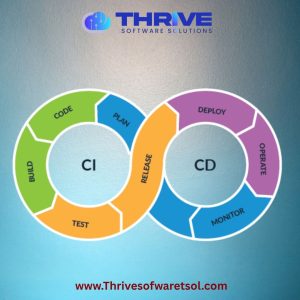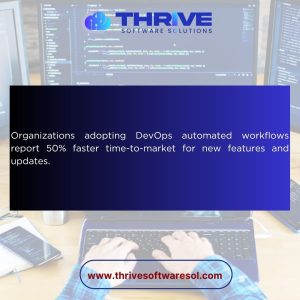The DevOps Technology Trends landscape is undergoing a revolutionary transformation as organizations worldwide accelerate their digital evolution. With the global DevOps market projected to reach $25.5 billion by 2028 at a remarkable 19.7% CAGR, businesses are recognizing that embracing modern DevOps Technology Trends isn’t just an option—it’s essential for survival in an increasingly competitive marketplace.
As we navigate through 2025, the convergence of artificial intelligence, security-first approaches, and platform engineering is fundamentally reshaping how teams build, deploy, and manage software. These DevOps Trends represent more than incremental improvements; they signify a paradigm shift toward intelligent, autonomous, and resilient software delivery systems that can adapt to market demands at unprecedented speed.
6 DevOps Trends To Know In 2025
1. AI-Driven DevOps (AIOps) Revolution
Artificial Intelligence has emerged as the most transformative force among current DevOps Technology Trends. The integration of AI and machine learning into DevOps workflows is creating self-healing systems that can predict failures before they occur. Organizations implementing AI-driven DevOps report 46 times more frequent deployments and 96 times faster recovery from failures compared to traditional approaches.
AIOps market growth reflects this trend’s importance, valued at $1.5 billion and expanding at a 15% compound annual growth rate. AI-powered tools are revolutionizing predictive analytics by analyzing historical deployment data to forecast potential system outages and performance bottlenecks. Machine learning algorithms now automatically generate test cases based on code changes, drastically reducing manual test creation and accelerating CI/CD pipelines.
The most compelling advancement is self-healing infrastructure. AI-driven systems automatically detect anomalies, diagnose root causes, and implement corrective actions without human intervention. This reduces Mean Time to Detection (MTTD) and Mean Time to Resolve (MTTR), fundamentally changing how teams approach incident management.
2. DevSecOps: Security by Design
Security integration represents one of the most critical DevOps Technology Trends as cyber threats become increasingly sophisticated. DevSecOps adoption has reached 37% of organizations, with security now embedded throughout the entire software development lifecycle rather than treated as an afterthought.
The shift-left security approach is transforming how teams handle vulnerabilities. By integrating security checks early in the development process, organizations reduce remediation costs and foster collaboration between developers and security experts. Automated security pipelines now include dynamic and static analysis, dependency scanning, and infrastructure compliance checks seamlessly integrated into CI/CD workflows.
AI-powered security monitoring is becoming standard practice. Machine learning algorithms analyze vast datasets from previous cyberattacks to detect patterns and flag potential issues before they escalate into significant threats. This proactive approach enables teams to maintain development velocity while ensuring robust security postures.
Zero Trust Architecture has emerged as a fundamental security model within DevOps Technology Trends. Every access request is authenticated and verified, regardless of source location, creating more resilient security frameworks for distributed development teams.
3. Platform Engineering: The Evolution of DevOps
Platform Engineering represents the natural evolution of DevOps Technology, focusing on creating Internal Developer Platforms (IDPs) that provide self-service capabilities for development teams. 89% of organizations now use internal developer platforms, with dedicated platform teams delivering 6% productivity gains at the team level.
Platform engineering addresses the cognitive overload challenge by abstracting infrastructure complexities into easily consumable services. Developers interact with simplified interfaces while platform teams manage the underlying infrastructure, security policies, and compliance requirements. This separation enables faster development cycles without sacrificing quality or governance.
Self-service portals are becoming the cornerstone of modern development workflows. These platforms integrate Infrastructure as Code (IaC), Kubernetes orchestration, CI/CD pipelines, and observability tools into unified experiences. Teams can provision infrastructure, deploy applications, and monitor performance without depending on centralized operations teams.
The product-centric approach to platform engineering treats developers as customers, ensuring platforms evolve based on user feedback and changing requirements. This methodology drives continuous improvement and ensures platforms remain relevant as DevOps Technology Trends evolve.
4. Serverless DevOps Architecture Trend
Serverless computing is fundamentally changing DevOps Technology Trends by abstracting server management entirely. Organizations implementing serverless DevOps report significant cost reductions through pay-per-use models and faster deployment cycles through event-driven architectures.
AWS Lambda, Google Cloud Functions, and Azure Functions are becoming standard deployment targets within DevOps Technology Trends. These platforms enable developers to focus exclusively on application logic while cloud providers handle scaling, patching, and infrastructure maintenance.
The microservices architecture alignment with serverless computing creates highly scalable and resilient applications. Each function performs specific tasks, enabling granular deployment strategies and reducing blast radius when issues occur. This modular approach accelerates development cycles and improves system reliability.
5. GitOps and Infrastructure as Code
GitOps has matured into a fundamental component of DevOps Technology Trends, with over 90% of Kubernetes deployments now managed using GitOps principles. This declarative approach uses Git repositories as the single source of truth for infrastructure and application configurations.
Automated reconciliation ensures deployed environments continuously match desired states defined in version control. When configuration drift occurs, GitOps agents automatically restore correct configurations, maintaining system reliability and compliance. This approach provides complete audit trails and enables rapid rollbacks when issues arise.
ArgoCD and Flux CD have emerged as leading GitOps tools, providing robust deployment automation for cloud-native applications. These platforms support sophisticated rollout strategies including blue-green and canary deployments, enabling safer release processes.
Infrastructure as Code integration with GitOps creates powerful automation workflows. Tools like Terraform, Pulumi, and OpenTofu work seamlessly with GitOps platforms to manage entire infrastructure lifecycles through declarative configurations.
6. Edge Computing and Distributed DevOps Technology Trends
Edge computing represents the frontier of DevOps Technology Trends, bringing computation closer to data sources and reducing latency for real-time applications. 75% of enterprise data processing is projected to occur at the edge by 2025, creating new challenges for distributed DevOps teams.
K3s lightweight Kubernetes and edge-native tools enable container orchestration in resource-constrained environments. DevOps teams must adapt CI/CD pipelines for deployment across millions of distributed devices while maintaining consistency and reliability.
5G network integration accelerates edge computing adoption by providing the bandwidth and latency characteristics required for real-time processing. Applications in autonomous vehicles, industrial automation, and smart infrastructure demand millisecond response times that traditional cloud architectures cannot consistently provide.
IoT device management within DevOps Technology Trends requires specialized tools for monitoring and updating distributed systems at scale. Teams implement sophisticated observability strategies capable of tracking performance across geographically distributed edge locations.
The Future of DevOps Technology Trends
The convergence of these six trends creates unprecedented opportunities for organizations willing to embrace change. 99% of organizations implementing DevOps report positive outcomes, with 61% experiencing improved software quality and 49% achieving faster time-to-market.
Success in 2025 requires balancing innovation adoption with operational stability. Organizations must invest in team skills development, establish robust governance frameworks, and maintain focus on user-centric outcomes. The DevOps Technology Trends shaping 2025 represent more than technological evolution—they embody a fundamental shift toward intelligent, autonomous, and resilient software delivery systems. Get in touch with Thrive Software Solutions for custom DevOps technology solutions in WA, USA.






